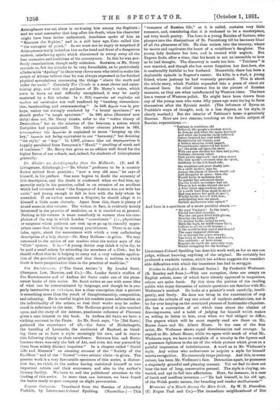Studies in English Art. (Second Series.) By Frederick Wedmore. (R.
Bentley and Bons.)—With one exception, these are essays on English artists, some of which have already appeared in magazines, others are quite fresh. By this time the portion of the reading public who enjoy discussion of artistic questions are familiar with Mr. Wedmore's method. He looks at a painter's work carefully, intelli- gently, and freely. He does not bring to the examination of any picture the criteria of any one school of analytic a3stheticism, nor is be for ever harping on the restricted phrases of fashionable cliqueisin. He has a conception of art which rises above the chatter of drawing-rooms, and a habit of judging for himself which makes us willing to listen to him, even when we feel obliged to differ. The papers which will be most eagerly read are those on Mr. Berne Jones and Mr. Albert Moore. In the case of the first artist, Mr. Wedmore shows equal discrimination and courage. In regard to Mr. Albert Moore, while we agree with much of what Mr. Wedmore says, we have to complain of a tenuity in the figures and a gossamer lightness in the air of the whole picture which gives us a painful impression of indefiniteness. A word as to Mr. Wedmore's style. Any writer who endeavours to acquire a style for himself merits recognition. He commonly reaps jealousy. And this, to some extent, has been Mr. Wedmore's fate. Detraction apart, he possesses a singularly graceful and pleasing manner. Yet we find he does not bear the test of long, consecutive perusal. The style is cloying, un- varied, and apt to fall into affectation. Here, for instance, is a case of harsh and needless inversion :—" He had himself, in his old age, of the Welsh poetic nature, the brooding and tender stedfastness."






























 Previous page
Previous page